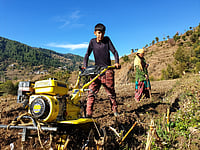Those who haven’t been to Kinnaur may think that the terrifying incident of landslide here was a freak event. They may also term it as an “accident” in the high altitude ecologically fragile Himalayan geology.
But, the death of nine tourists- three of them from a single family- and army personnel who were crushed under massive boulders that slid down a hill following a landslide on Sunday was not just a coincidence related to monsoon flash floods unlike Dharamshala and massive mountain slide in Sirmaur district following incessant monsoon rains.
Has Kinnaur become a new Himalayan hotspot for disasters due to thoughtless interference with fragile ecology, ecosystem and mountain biodiversity?
A video of the massive boulders sliding down blasting down a bridge like ‘bombs’ at Batseri on Sangla, Chitkul road is a tell- tale evidence of how the high mountains are slowly sliding, breaking off and crumbling down due to reckless environmental destruction to build large dams, roads and tunnels for mega hydel projects.
Some geological experts believe natural courses of the streams, a few of which are flowing underbelly and inside the mountains, are either getting blocked or diverted, resulting in landslides, rockslips and downhill movement of boulders threatening the lives of tourists and locals.
With more than 143 hydel projects planned in the Sutlej basin--where the tribal had lived with nature, protected and saved the resources like water and forests from commercial exploitation-- disasters like the one in Chamoli (2021) and Kedarnath (2013) are quite predictable.
Apart from mega projects like 1500 Nathpa-Jhakri, 1000 MW Karcham Wangtoo 300 MW Baspa-II, some of the highly controversial run-of-the river projects viz Shongthong Karchham (450 MW) Jangi Thopan (840 MW) and Kashang –I,& II, beside Tidong (100 MW) are already at different stages of execution.
Massive diversion of the rivers viz Sutlej, Baspa and its tributaries, cutting and flattening of the land, tunnel boring, blasting, hollowing of the mountains, diversion of the forest lands, movement of heavy machines and even dumping of the debris tonnes along the river beds and fields are some of the activities bound to destabilise the ecology and biodiversity in Kinnaur .
Avay Shukla, a former Additional Chief Secretary (Forest), who headed the High Court panel to study impact of hydel project on the mountain ecology, says “Hydel projects in the Himalayan region have a dual effect: they act as triggers for natural occurrences such as landslides, avalanches, flash floods as well as reduce nature's capacity to absorb these events/disasters.”
“The Sangla accident is the inevitable fall out of the reckless exploitation of the Sutlej basin for hydel projects. The 142 projects on the river, with continuous blasting, tunnelling, and road construction have destabilised the fragile mountain strata and it will continue to slide for years” he explains.
So, are panicked environmental groups asking for a complete ban on hydel projects at high altitude region of Kinnaur and Lahaul-Spiti ,including Sutlej basin?
Mansi Asher, a leading environmental activist, feels “the blasting and tunnelling have high potential for triggering and / or accelerating the landslides in these regions. There is an urgent need of study on rapid land-use changes impacting the local terrestrial ecosystem. The Sangla landside is surely a frightening event.”
Incidences and landslides are common across the Himalayas because of the pre-existing geological fragility of the landscape itself. It catches media attention only when the loss/damage is huge.
The climate crisis on one hand has led to increasing temperatures and erratic rainfall patterns in combination with unplanned and haphazard development that leads to disaster-like situations.
She claims that Kinnaur is already identified as a high landslide and disaster-prone zone. And yet it is the hub of intense construction activity like hydropower and massive land-use changes .This is the most worrying trend.
Avay Shukla concludes, saying, " A callous and vision-less state government is deaf and blind to a continued vandalism in Sutlej basin .How Many deaths will it take to convince it that enough is enough !"


























